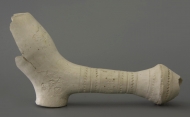Show piece full of riddles
février 2004

Recently this special tobacco pipe was excavated in the Wetering area in Amsterdam. It is not a standard size pipe, but a large one. The bowl, for example, has a height of more than eight centimeters, compared to less than four centimeters for the current pipe of that time. Much has been speculated about the function of such pipes. We now know that the idea that it is a guild piece is certainly not correct. Rather it seems to be a pipe as a shop sign or an object that was used as an advertisement. The pipe follows the then prevailing standard shape, but is not pressed in series but entirely moulded by hand. As a result, the balance have become slightly disproportionate, while hand-moulding also caused tension in the clay, causing shrinkage cracks. In the stem of such large pipes, a disk or knot was added to make the appearance more impressive. Apparently the pipe maker wanted to emphasize the special features of the product with such an accent. Many of such large size pipes are lavishly decorated with stamps and that is precisely what happened here in moderation. Because the TIP stamp has been used several times, we can assume that the maker is de Gouda pipe maker Thiel Jansz. Proost. He started his company in 1636 and continued to work well into the 1680s. A remarkable detail is the appearance of the "marigold" mark, which was hardly in demand at the time this pipe was made. The use of this stamp is as unexplained as the image of the heel stamp with double-headed eagle above which "HASELDOC" can be read. In that regard, there are still some mysteries about this object.
Amsterdam Pipe Museum APM 17.313
Archives des objets du mois